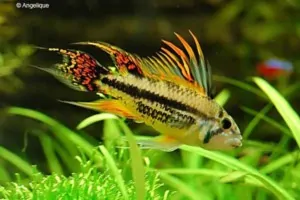Apistogramma
The genus Apistogramma belongs to the family Cichlidae or cichlids. Currently, there are more than 90 officially described species with a large number of undescribed species.
The genus name Apistogramma can be broken down into two ancient Greek words. Apisto means uncertain and gramma means signal. This is a reference to the variably developed lateral line, which largely consists only of pore scales.
Description
The Apistogramma species are counted among the Dwarf Cichlids. The males are often slightly larger than the females, typically reaching between seven and nine centimeters in length. The males are somewhat brighter in color and often have a clearly recognizable color and pattern per species. Many Apistogramma women do look alike. From a dull gray/brown to a yellow color with a black mask when they are in the mating season.
Origin
The species of the Apistogramma genus are found in the tropical and subtropical waters of South America. Some species occur in somewhat larger areas, but many of the Apistogrammas can be found in a limited distribution area.
Apistogrammas inhabit the basin of the Amazon, Rio Orinoco, Rio Tocantins, Rio Araguaia, Rio Parnaiba, and Rio de la Plata, among others. The countries where they live are Argentina, Bolivia, Brazil, Colombia, Ecuador, French Guiana, Guyana, Paraguay, Peru, Suriname, Uruguay and Venezuela.
Diet
In the wild, Apistogramma search for small invertebrates. Worms, insects, larvae, but also pieces of algae. It is omnivorous, preferring small live foods.
Apistogramma reproduction
Within the Apistogramma genus, there are several methods of reproduction. Many of the species lay their eggs in burrows or crevices. They do this between pieces of wood, branches, or under leaves. A number of species are truly monogamous while other species form a harem. Usually, both parents take care of the eggs and fry, but usually the female fans and cares for the eggs. The Apistogramma male guards the surroundings and scares off predators.
Mouthbrooding species
Not all Apistogramma species lay their eggs in a burrow. Three species are known to incubate the eggs in their mouths: Apistogramma barlowi, Apistogramma megastoma, and Apistogramma pantalone.
.

Showing all 4 results
Showing all 4 results




